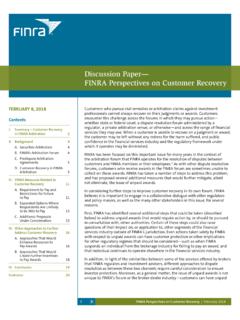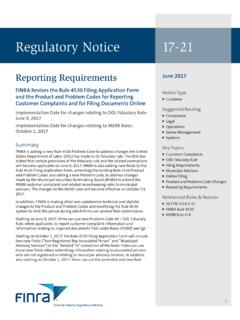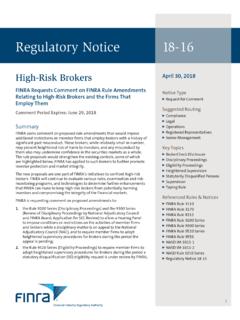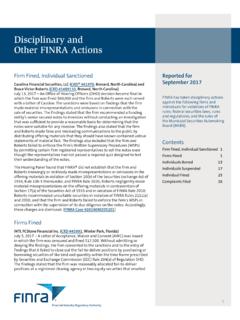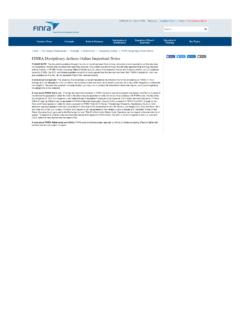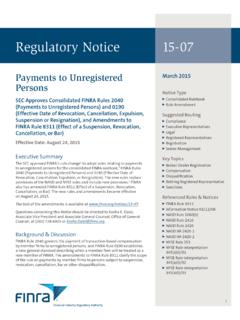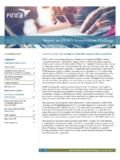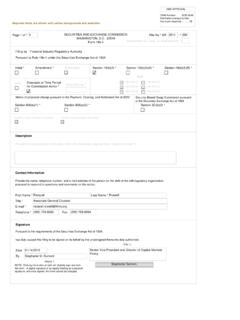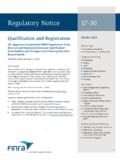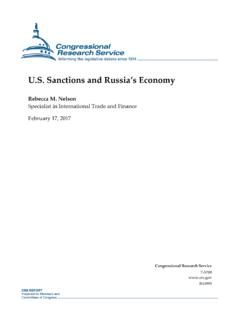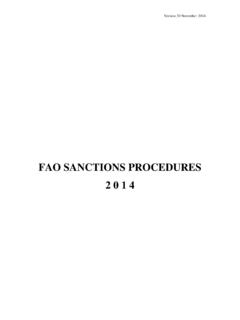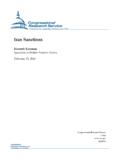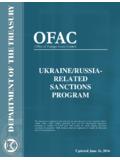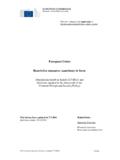Transcription of May 2018 Sanction Guidelines - finra.org
1 Sanction GuidelinesMay 2018 Table of Contents 2018. finra . All rights reserved. May 2018 version of the Sanction 1 General Principles Applicable to All Sanction Determinations 2 Principal Considerations in Determining sanctions 7 Applicability 8 Technical Matters 9I. Activity Away From Associated Person s Member Firm 12II. Arbitration 17 III. Distributions of Securities 19IV. Financial and Operational Practices 25V. Impeding Regulatory Investigations 31VI. Improper Use of Funds/Forgery 35 VII. Qualification and Membership 38 VIII. Quality of Markets 46IX. Reporting/Provision of Information 69X. Sales Practices 76XI. Supervision 100 Index 1081 INDEXTOCThe regulatory mission of finra is to protect investors and strengthen market integrity through vigorous, even-handed and cost-effective self-regulation.
2 finra embraces self-regulation as the most effective means of infusing a balance of industry and non-industry expertise into the regulatory process. finra believes that an important facet of its regulatory function is the building of public confidence in the financial markets. As part of finra s regulatory mission, it must stand ready to discipline member firms and their associated persons by imposing sanctions when necessary and appropriate to protect investors, other member firms and associated persons, and to promote the public interest. The National Adjudicatory Council (NAC), formerly the National Business Conduct Committee, has developed the finra Sanction Guidelines for use by the various bodies adjudicating disciplinary decisions, including Hearing Panels and the NAC itself (collectively, the Adjudicators), in determining appropriate remedial sanctions .
3 finra has published the finra Sanction Guidelines so that members, associated persons and their counsel may become more familiar with the types of disciplinary sanctions that may be applicable to various violations. finra staff and respondents also may use these Guidelines in crafting settlements, acknowledging the broadly recognized principle that settled cases generally result in lower sanctions than fully litigated cases to provide incentives to settle. OverviewThese Guidelines do not prescribe fixed sanctions for particular violations. Rather, they provide direction for Adjudicators in imposing sanctions consistently and fairly.
4 The Guidelines recommend ranges for sanctions and suggest factors that Adjudicators may consider in determining, for each case, where within the range the sanctions should fall or whether sanctions should be above or below the recommended range. These Guidelines are not intended to be absolute. Based on the facts and circumstances presented in each case, Adjudicators may impose sanctions that fall outside the ranges recommended and may consider aggravating and mitigating factors in addition to those listed in these Guidelines . These Guidelines address some typical securities-industry violations. For violations that are not addressed specifically, Adjudicators are encouraged to look to the Guidelines for analogous violations.
5 In order to promote consistency and uniformity in the application of these Guidelines , the NAC has outlined certain General Principles Applicable to All Sanction Determinations that should be considered in connection with the imposition of sanctions in all cases. Also included is a list of Principal Considerations in Determining sanctions , which enumerates generic factors for consideration in all cases. Also, a number of Guidelines identify potential principal considerations that are specific to the described violation. 2 INDEXTOC1. Disciplinary sanctions should be designed to protect the investing public by deterring misconduct and upholding high standards of business conduct.
6 The purpose of finra s disciplinary process is to protect the investing public, support and improve the overall business standards in the securities industry, and decrease the likelihood of recurrence of misconduct by the disciplined respondent. Toward this end, Adjudicators should design sanctions that are meaningful and significant enough to prevent and discourage future misconduct by a respondent and deter others from engaging in similar misconduct. sanctions should be more than a cost of doing business. sanctions should be a meaningful deterrent and reflect the seriousness of the misconduct at issue. To meet this standard, certain cases may necessitate the imposition of sanctions in excess of the upper Sanction guideline.
7 For example, when the violations at issue in a particular case have widespread impact, result in significant ill-gotten gains, or result from reckless or intentional actions, Adjudicators should assess sanctions that exceed the recommended range of the , as Adjudicators apply these principles and tailor sanctions , Adjudicators should consider a firm s size with a view toward ensuring that the sanctions imposed are remedial and designed to deter future misconduct, but are not punitive. Factors to consider in connection with assessing a firm s size are: the financial resources of the firm; the nature of the firm s business; the number of individuals associated with the firm; and the level of trading activity at the firm.
8 This list is included for illustrative purposes and is not exhaustive. Other factors also may be considered in connection with assessing firm See, , Dep t of Enforcement v. Murray, Complaint No. 2008016437801, 2012 finra Discip. LEXIS 64, at *31 ( finra OHO Oct. 25, 2012) (finding that respondent s disregard of his supervisory duties supported sanctions above the range recommended by the Sanction Guidelines ), aff d, 2013 finra Discip. LEXIS 33, at *5 ( finra NAC Dec. 17, 2013). 2. Adjudicators may consider a firm s small size in connection with the imposition of sanctions with respect to rule violations involving negligence.
9 With respect to violations involving fraudulent, willful or reckless misconduct, Adjudicators should consider whether, given the totality of the circumstances involved, it is appropriate to consider a firm s small size and may determine that, given the egregious nature of the fraudulent activity, firm size will not be considered in connection with Principles Applicable to All Sanction Determinations2. Disciplinary sanctions should be more severe for recidivists. An important objective of the disciplinary process is to deter and prevent future misconduct by imposing progressively escalating sanctions on recidivists beyond those outlined in these Guidelines , up to and including barring associated persons and expelling firms.
10 sanctions imposed on recidivists should be more severe because a recidivist, by definition, already has demonstrated a failure to comply with finra s rules or the securities laws. The imposition of more severe sanctions emphasizes the need for corrective action after a violation has occurred, discourages future misconduct by the same respondent, and deters others from engaging in similar should always consider a respondent s relevant disciplinary history in determining sanctions and should ordinarily impose progressively escalating sanctions on recidivists. With respect to individual respondents, adjudicators should consider Disciplinary and Arbitration History.
